Complete Solutions to EXERCISE of chapter QUADRILATERALS of Class 9 book with complete answers and questions
| Class 9 | MATHS |
| Chapter | QUADRILATERALS |
| NCERT TELUGU | EXERCISE |
| Number Of Questions | 80 |
| Academic Year | 2023-24 |
State whether the statements are True or False.
(i) Every parallelogram is a trapezium ( )01:23View SolutionState whether the statements are True or False.
(ii) All parallelograms are quadrilaterals ( )01:22View SolutionState whether the statements are True or False.
(iii) All trapeziums are parallelograms ( )01:57View SolutionState whether the statements are True or False.
(iv) A square is a rhombus ( )01:28View SolutionState whether the statements are True or False.
(v) Every rhombus is a square ( )01:20View SolutionState whether the statements are True or False.
(vi) All parallelograms are rectangles01:27View SolutionComplete the following table by writing (YES) if the property holds for the particular Quadrilateral and (NO) if property does not holds.
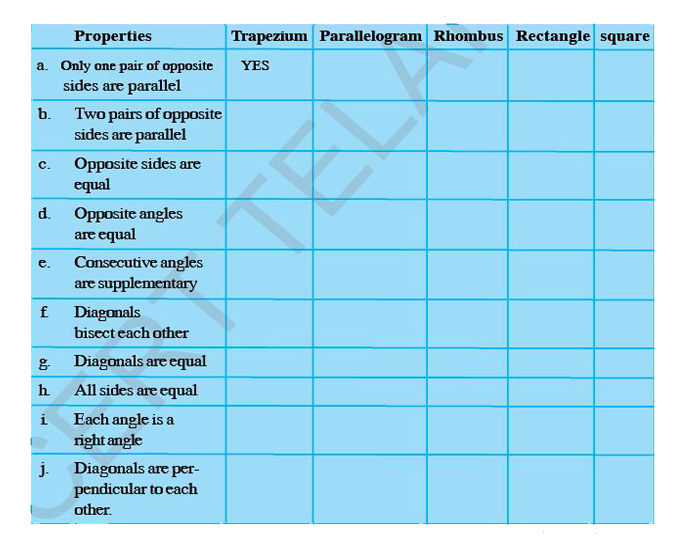 05:08View Solution
05:08View SolutionABCD is trapezium in which `AB"||"CD`. If `AD =BC`, show that `angleA=angleB` and `angleC and angleD`.
05:58View SolutionThe four angles of a quadrilateral is in the ratio of 1: 2:3:4. Find the measure of each angle of the quadrilateral.
02:25View SolutionABCD is a rectangle AC is diagonal. Find the nature of `DeltaACD`. Give reasons.
03:06View SolutionIn the adjacent figure ABCD is a parallelogram ABEF is a rectangle show that `DeltaAFD~=DeltaBEC`.
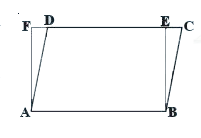 03:39View Solution
03:39View SolutionShow that the diagonals of a rhombus divide it into four congruent triangles.
04:29View SolutionIf a quadrilateral ABCD, the bisector of `angleC angleD` intersect at O.
Prove that `angleCOD=(1)/(2)(angleA+angleB)`04:11View SolutionThe opposite angles of a parallelogram are `(3x-2)^@` and `(x+48)^@`. Find the measure of each angle of the parallelogram.
02:44View SolutionFind the measure of all the angles of a parallelogram, if one angle is `24^(@)` less than the twice of the smallest angle.
02:19View SolutionIn the adjacent figure ABCD is a parallelogram and E is the midpoint of the side BC. If DE and AB are produced to meet at F, show that `AF=2AB`.
06:44View SolutionIn the adjacent figure a parallelogram and P, Q are the midpoints of sides AB and DC respectively. Show that PBCQ is also a parallelogram.
05:20View SolutionABC is an isosceles triangle in which `AB = AC. AD` bisects exterior angle `QAC and CD "||" BA` as shown in the figure. Show that
(i) `angleDAC = angleBCA`
(ii) ABCD is a parallelogram
 06:33View Solution
06:33View SolutionABC is an isosceles triangle in which `AB = AC. AD` bisects exterior angle `QAC and CD "||" BA` as shown in the figure. Show that
(i) `angleDAC = angleBCA`
(ii) ABCD is a parallelogram
 06:33View Solution
06:33View SolutionABCD is a parallelogram and AP and CQ are perpendicular from vertices A and C on diagonal BD (see figure) show that : `/_\APB` ~= `/_\CQD`
 06:14View Solution
06:14View SolutionABCD is a parallelogram AP and CQ are perpendiculars drawn from vertices A and C on diagonal BD (see figure)..Show that : i) `DeltaAPB = DeltaCQD`.
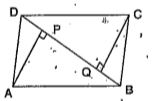 03:46View Solution
03:46View SolutionIn `Delta^s` ABC and DEF, DE and `AB || DE`, `BC=EF` and `BC || EF`. Vertices A, B and C are joined to vertices D, E and F respectively (see figure). Show that : ABED is a parallelogram.
 02:43View Solution
02:43View SolutionIn `Delta^s` ABC and DEF, DE and `AB || DE`, `BC=EF` and `BC || EF`. Vertices A, B and C are joined to vertices D, E and F respectively (see figure). Show that : BCFE is a parallelogram.
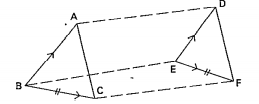 02:23View Solution
02:23View SolutionIn `Delta^s` ABC and DEF, DE and `AB || DE`, BC=EF and `BC || EF`. Vertices A, B and C are joined to vertices D, E and F respectively (see figure). Show that :` AC=DF`
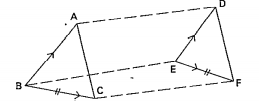 02:18View Solution
02:18View SolutionIn `Delta^s` ABC and DEF, DE and `AB || DE`, BC=EF and `BC || EF`. Vertices A, B and C are joined to vertices D, E and F respectively (see figure). Show that : `/_\ABC` ~= `/_\DEF`
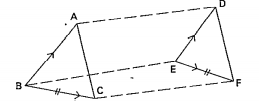 04:01View Solution
04:01View SolutionABCD is a parallelogram. AC and BD are the diagonals intersect at O. P and Q are the points of tri section of the diagonal BD. Prove that `CQ" ||" AP` and also AC bisects PQ (see figure).
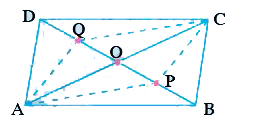 06:31View Solution
06:31View SolutionABCD is a square. E, F, G and H are the mid points of `AB, BC, CD and DA` respectively. Such that `AE = BF = CG = DH`. Prove that EFGH is a square.
07:59View SolutionDraw a triangle ABC and mark the midpoints E and F of two sides of triangle. `bar(AB) and bar(AC)` respectively. Join the point E and F as shown in the figure.
Measure EF and the third side BC of the triangle. Also measure `angleAEF and angleABC`.
We find `angleAEF = angleABC and bar(EF)=(1)/(2)bar(BC)`
As these are corresponding angles made by the transversal AB with lines EF and BC, we say `EF"||"BC.`
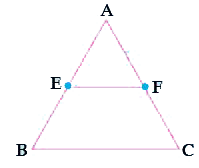 04:44View Solution
04:44View SolutionABC is a triangle . D is a point of AB such that `AD=(1)/(4)AB and E` is a point on AC such that `AE=(1)/(4)AC.` If `DE =2cm` find BC.
02:35View SolutionABCD is quadrilateral E, F, G and H are the midpoints of `AB, BC, CD and DA` respectively. Prove that EFGH is a parallelogram.
05:37View SolutionShow that the figure formed by joining the midpoints of sides of a rhombus successively is a rectangle.
09:42View SolutionIn a parallelogram ABCD, E and F are the midpoints of the sides AB and DC respectively. Show that the line segments AF and EC trisect the diagonal BD.
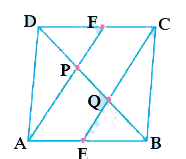 06:51View Solution
06:51View SolutionShow that the line segments joining the midpoints of the opposite sides of a quadrilateral and bisect each other.
05:08View SolutionABC is a triangle right angled at 'C'. A line through the midpoint M of hypotenuse AB and parallel to BC intersects AC at D. Show that : D is the midpoint of AC.
 03:59View Solution
03:59View SolutionABC is a triangle right angled at C. A line through the midpoint M of hypotenuse AB and parallel to BC Intersects AC at D. Show that : `MD_|_ AC`
 02:52View Solution
02:52View SolutionABC is a triangle right angled at 'C'. A line through the midpoint M of hypotenuse AB and parallel to BC intersects AC at D. Show that : `CM = MA = 1/2 AB` .
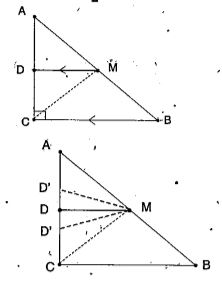 03:59View Solution
03:59View SolutionABCD is a parallelogram and P is a point of `bar(CD)`. Show that `ar(/_\ABP)` = `ar(/_\ADP+ /_\BCP)`.
06:21View SolutionPQRS is a parallelogram. K. L are the midpoints on PQ, RS respectively. `bar(PL)` intersects `bar(SK)` at M and RK and QL intersects at N. Show that KNLM is a parallelogram.
05:17View SolutionABCD is a parallelogram and P, Q are the mid points of `bar(AD)` and `bar(BC)` respectively such that AP=1/3AD and CQ=1/3BC,Show that : AQCP is a parallelogram.
11:09View SolutionABCD is a parallelogram and P, Q are the mid points of `bar(AD)` and `bar(BC)` respectively. Show that : `bar(BD)` and `bar(PQ)` bisect each other.
04:05View SolutionIn `/_\ABC`, AD is the median on `bar(BC)`. 'E' is the midpoint of AD. Draw `bar(BF)` through E. Show that `AF = `1/3`AC`
09:52View SolutionIn a Parallelogram PQRS, `/_SPQ=70^@ and angle SQR=65^@`. Find the other angles of the parallelogram.
05:07View SolutionIn a parallelogram ABCD, `angleABC=50^@`.Find the other angles.
03:40View SolutionThe four angles of a quadrilateral is in the ratio of 3:4:5: 6. Find the measure of each angle.
03:08View SolutionThe four angles of a quadrilateral is in the ratio of 2 : 3:5: 8. Find the measure of each angle.
03:01View SolutionThe opposite angles of a parallelogram are `(2x - 3)^@` and `(x + 4)^@`. Find each angle of its angles.
03:10View SolutionIn `/_\ABC`, P, Q, R are the mid points of `bar(AB), bar(BC), bar(CA)` respectively. If area of `/_\POR=3` sq. units. Find the area of the `/_\ABC`.
03:12View SolutionThe sum of the measures of two con secutive sides of a parallelogram is 18 cm. Find its perimeter.
03:14View SolutionIn `/_\ABC`, D, E, F are the mid-points of `bar(AB)`, `bar(BC)`, `bar(CA)` and if `bar(AB)`= 11 cm, `bar(BC)` = 9 cm, `bar(CA)` = 8cm. Find the lengths of `bar(DE)`, `bar(EF)` and `bar(DF)`.
 05:13View Solution
05:13View SolutionIn `/_\PQR`, A, B, C are the mid-points of `bar(PQ), bar(QR), bar(RP)` and if AB=4 cm, BC=6cm, AC=5cm. Find `bar(PQ), bar(QR), bar(RP)`.
02:25View SolutionABCD is a trapezium. AB || CD, P, Q are the mid-points AD and BC respectively. If` AB=10cm, `CD=18 cm, then PQ=?
02:39View SolutionKLMN is a trapezium and KL || MN. P, Q are the midpoints of KN and LM respectively. If `KL=18 cm, `PQ=10 cm, Find MN=?
03:06View SolutionABC is a triangle . D is a point of AB such that `AD=(1)/(4)AB and E` is a point on AC such that `AE=(1)/(4)AC.` If `DE =2cm` find BC.
02:35View SolutionIn `triangleKLM`, P is the midpoint of KL. such that KP = `1/4`KL and Q is the midpoint on KM such that KQ=`1/4`KM and if PQ =11 cm. Find LM?
04:40View SolutionAny two consecutive angles of a parallelogram are
02:19View SolutionShow that the diagonals of a square are equal and right bisectors of each other.
07:29View SolutionIf a parallelogram has its sides equal and each angle is `90^@`, then it is called_____.
01:57View SolutionIn a parallelogram PQRS, if `/_P` = `70^@`, then `/_R`= _____.
01:49View SolutionIf two adjacent sides of a parallelogram are `3.5`, `6 cms`. Then its perimeter is ___.
01:59View SolutionThe angle bisectors of a parallelogram form a
02:10View SolutionIn the adjacent figure ABCD is a parallelogram angle A=50^@ and angle c=?
02:07View SolutionIn `/_\ABC`, `bar(AD) and bar(BE)` are the midpoints of `bar(BC)` and `bar(AC)`. If `AC=10 cm`, then CE =
03:40View SolutionABCD is a trapezium in which `AB||CD`. P and Q are midpoints of `bar(AD)` and`bar(BC)` respectively. If `AB=10 cm, `PQ=8 cm, then `CD=____`.
02:34View SolutionIn a figure `bar(PQ)`|/|`bar( BC)` and P, Q are midpoints of `bar(AB)`, `bar(AC)` respectively. If `PQ=4cm`, then `BC=_____`.
04:30View SolutionFill in the Blanks :A figure formed by joining the mid points of a parallelogram is_________
01:44View SolutionFill in the Blanks:If the mid-points of the sides of a square are joined the figure so formed is____
02:23View SolutionFill in the Blanks:The sum of four angles in a quadrilateral is_______right angles.
02:23View SolutionFill in the Blanks:In a parallelogram PQRS, the bisectors of consecutive angles P and Q intersect at K.`angle PKQ`=____.
03:04View SolutionThe angles of a quadrilateral are in ratio of 2:3:4:6. Find the measure of smallest angle.
02:46View SolutionA parallelogram in which two adjacent sides are
equal is a ……….01:50View SolutionFill in the Blanks:The diagonals of a rhombus divide it into____ congruent angles.
05:59View SolutionFill in the Blanks:The diagonals of a rectangle are of____
01:42View SolutionFill in the Blanks:The diagonals of a square are equal and__________each other.
03:31View SolutionFill in the Blanks:The ratio of areas of a triangle and 9 par allelogram are on the base and between the same parallel lines is______
03:47View SolutionABCD is a parallelogram and P is a point of `bar(CD)`. Show that `ar(/_\ABP)` = `ar(/_\ADP+ /_\BCP)`.
06:21View SolutionIf `A=45^o` then find the value of `tan2A`.
01:37View SolutionIn a parallelogram ABCD, `angleABC=50^@`.Find the other angles.
03:40View SolutionThe four angles of a quadrilateral is in the ratio of 2: 3:5:8. Find the measure of each angle.
02:34View SolutionIf the sum of two adjacent sides of a parallelogram is 32 cm. Find its perimeter.
02:27View SolutionIn `triangleKLM`, P is the midpoint of KL. such that KP = `1/4`KL and Q is the midpoint on KM such that KQ=`1/4`KM and if PQ =11 cm. Find LM?
04:40View Solution
EXERCISE questions and complete solutions for chapter QUADRILATERALS of NCERT Maths(Telugu) of Class 9
